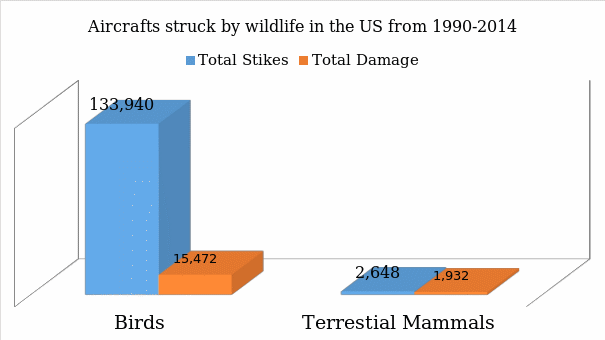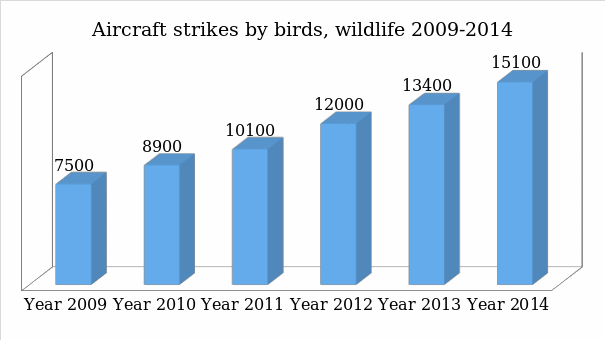Introduction
Managing airport security and safety is one of the most important responsibilities of aviation authorities around the world. One of the problems that many airports face is animal and bird incursions in and around airports. According to Biondi, Belant, Martin, DeVault, and Wang (2014), the threat posed by large terrestrial animals is almost negligible because of the use of fences that limit their movement into the airport. However, bird strikes are still common. Predicting the movement of birds and managing their behavioral pattern is almost impossible. It explains why cases of bird strikes are becoming more common despite the effort made by the stakeholders in the industry to solve the problem. In this paper, the researcher seeks to find a way of addressing this problem.
Problem Statement
Managing wildlife incursion in and around airports is a major concern in the aviation sector. On January 15, 2009, US Airways Flight 1549 was forced to make a dangerous landing on Hudson River following an engine failure due to a bird strike. The unique skills and experience of the pilot made it possible to perch the large aircraft safely on the water, saving the lives of 155 people on board (Atwell, Hilterbrand, Kaffka, Lauber, & Shore, 2015). Several cases have been witnessed in the past where lives are lost because of bird strikes that result in crashes. One of the worst cases was on Eastern Air Lines Flight 375 where 62 lives were lost after the plane crashed because of a bird strike. Such incidences and accidents often lead to serious damages of the planes to the tunes of millions of dollars.
Justification of the Study
According to Desoky (2014), the problem of intrusion of wildlife into airports has been a major concern for decades. Mechanisms put in place to prevent terrestrial mammals from accessing airports, especially the runways, has been successful. However, dealing with the threat posed by birds has been an issue. A study by Desoky (2014) reveals that airline companies around the world spend billions of dollars to repair and replace aircrafts and aircraft components damaged by bird strikes. Such massive losses can be eliminated if proper mechanisms are developed to deal with the problem. The significance of the problem makes the study justifiable. It will help stakeholders in the aviation industry to have a better approach to dealing with the problem than what is currently in use.
Statistical Analysis of the Challenges Posed by Wildlife

The statistical analysis conducted in this study revealed that bird strikes are the most common wildlife problems which the aviation industry faces. From 1990 to 2014, the United States alone registered over 133,940 bird strikes. The data shows that within the same period, a total of 15,472 planes suffered varying degrees of damage because of the collision with birds. Terrestrial mammals also pose serious threats to planes in various airports during takeoffs and landing. From 1990 to 2014, a total of 2,648 terrestrial mammals were struck on the runway. They include people who find themselves on the runways at a wrong time. 1,932 damages were reported from these strikes within the same period. As Dolbeer and Franklin (2013) observe, most of the strikes involving terrestrial mammals often lead to significant damage to the planes.

It was necessary to narrow the focus to bird strikes as it is evident that it remains one of the main concerns in the aviation security. As shown in the graph above, there has been a consistent increase in the number of bird strikes from 2009 to 2014. Although most of these incidences pose no major threats to the safety of the aircraft, it is still a major concern because sometimes it may result into major accidents as have been witnessed in the past. The number of bird strikes in 2014 was almost twice as much as it was in 2009. Scheideman et al. (2017) attribute the increase to the fact that the number of planes in the sky has been on the rise. Stakeholders in this industry are also considering moving towards structural design as a way of dealing with the problem because of the difficulty in predicting managing the behavioral pattern of birds.
Relevant Training to Improve Efficiency and Safety in the Airports
It may not be possible to eliminate any possibility of collision between wildlife and planes. As such, air crash investigators and aviation experts have often proposed the need to equip various experts in this industry with relevant skills that can enable them deal with such incidences. In this paper, it has been proposed that training is needed for different stakeholders based on their role within this industry. Pilots and crew members should be equipped with skills that can enable them avoid or successfully deal with such collisions to protect lives and property. Air traffic controllers should know the pattern of movements of local birds so that they can guide pilots effectively. Emergency team should always be ready to offer the needed help when there is emergency landing as a result of wildlife strike.
Radar Tracking Systems
The radar tracking system is one of the new technological concepts which are becoming increasingly relevant on managing the problem of collision between an aircraft and animals. Radar (RAdio Detection and Ranging) “is an electronic detector system that measures distance or velocity by sending a signal out and receiving its return” (Stolzer & Goglia, 2016, p. 56). This gadget may be the solution to the problem of collision between planes and any other objects on their path, whether living or non-living. Once the object is detected, its exact location, direction, and speed will be sent to the pilot for an appropriate measure to be taken. A pilot can find a way of avoiding the object by changing the planes altitude or direction in time before the strike.
Safety Programs, Control Measures, and Procedures
According to Sheridan et al. (2015), it is critical to ensure that there are safety programs, control measures, and procedures that must be followed within airports and in airplane to ensure that cases of collision between planes and any object is eliminated. The management of the airport must conduct a regular inspection of the runways to avoid any strange objects, including people who may be engaged with routine cleaning during landing and takeoffs. A standard procedure should be developed and followed, which includes inspection of the runways and the environment around the airport to enhance safety of the planes when coming into or leaving the airports. As a control measure, it may be necessary for the airport management to ensure that the immediate environment surrounding the airport do not become safe grounds for birds. Birds should be driven away from such environment using various mechanisms.
Structural Improvement and Legal Factors
In this paper, it has been explained that managing birds’ movement up in the sky may not be possible. As such, air crash investigators have recommended structural changes to the planes’ structures to ensure that they are capable of withstanding bird strikes. One of the most sensitive parts of the plane is the engine. Stolzer and Goglia (2016) say that measures should be put in place to protect the engine from birds and other objects without compromising its quality. The plane’s windscreen should also be strengthened to withstand such strikes. It is also necessary to have laws and regulations that define how airports and airlines should coordinate to avoid or minimize such strikes. The responsibility of every stakeholder should be clearly defined. They should be reminded that any act of negligence may result into legal actions against them, especially when lives are lost or properties damaged.
Recommendations
The study has proposed a number of recommendations that should be considered to help address the problem of wildlife incursion in and around airports. To deal with the problem of bird strikes, a structural redesign of the planes is recommended to ensure that the engines and other sensitive parts can withstand collisions with various objects. The use of radar system should also be employed. The cabin crew and airport employees should go through regular training to enhance their capacity to deal with cases of emergency. The management of the airports should also be aware that they have a responsibility of making the airports and immediate environment safe.
References
Atwell, N., Hilterbrand, J., Kaffka, C., Lauber, A., & Shore, E. (2015). Hillsboro Airport wildlife hazard management plan. Portland, OR: Port of Portland.
Biondi, K. M., Belant, J. L., Martin, J. A., DeVault, T. L., & Wang, G. (2014). Integrating mammalian hazards with management at US civil airports: A case study. Human-Wildlife Interactions, 8(1), 31-38.
Desoky, A. S. S. (2014). A review of bird control methods at airports. Global Journal of Science Frontier Research: E Interdisciplinary, 14(2), 40-50.
Dolbeer, R. A., & Franklin, A. B. (2013). Population management to reduce the risk of wildlife–aircraft collisions. In T. L. DeVault, B. F. Blackwell, and J. L. Belant (Eds.), Wildlife in airport environments: Preventing animal–aircraft collisions through science-based management (pp. 67-78). Baltimore, MD: The Johns Hopkins University Press.
Sheridan, E., Randolet, J., DeVault, T. L., Seamans, T. W., Blackwell, B. F., & Fernández-Juricic, E. (2015). The effects of radar on avian behaviour: Implications for wildlife management at airports. Applied Animal Behaviour Science, 171, 241-252.
Scheideman, M., Rea, R., Hesse, G., Soong, L., Green, C., Sample, C., & Booth, A. (2017). Use of wildlife camera traps to aid in wildlife management planning at airports. Journal of Airport Management, 11(4), 408-419.
Stolzer, A.J. & Goglia, J.J. (2016). Safety management systems in aviation (2nd ed.). New York, NY: Routledge.
